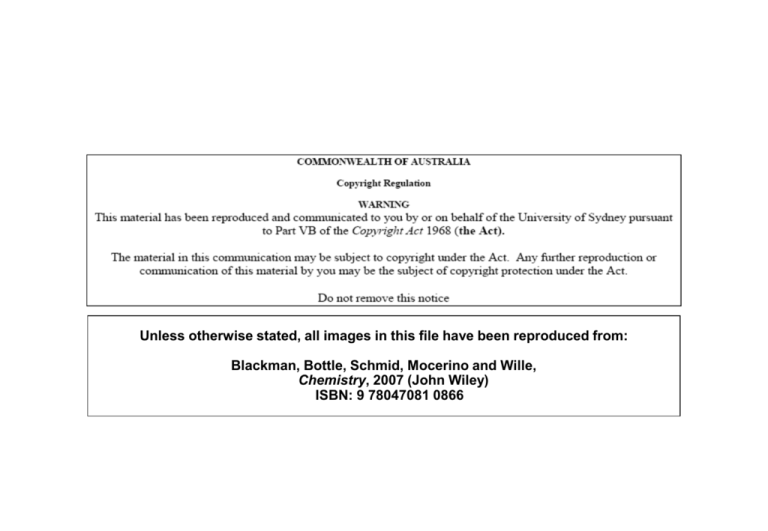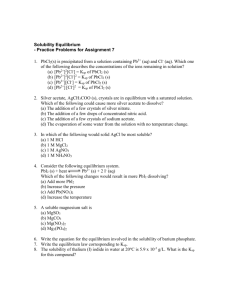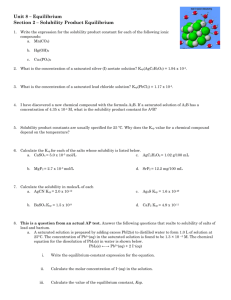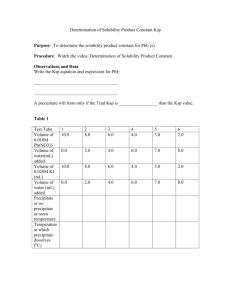pptx
advertisement

Unless otherwise stated, all images in this file have been reproduced from:
Blackman, Bottle, Schmid, Mocerino and Wille,
Chemistry, 2007 (John Wiley)
ISBN: 9 78047081 0866
e
CHEM1002 [Part 2]
A/Prof Adam Bridgeman (Series 1)
Dr Feike Dijkstra (Series 2)
Weeks 8 – 13
Office Hours:
Room:
e-mail:
e-mail:
Monday 2-3, Friday 1-2
543a
adam.bridgeman@sydney.edu.au
feike.dijkstra@sydney.edu.au
Slide 2/13
e
Summary of Last Lecture
Solubility Equilibria I
•
•
•
•
Saturated solutions contains solid salts in equilibrium with
the maximum amount of the ions in solution that is possible
The solubility product (Ksp) is the equilibrium constant for
this equilibrium situation
The solubility product (Ksp) gives the maximum
concentrations of the ions in the solution and the maximum
amount of solid that will dissolve
The ionic product (Qsp) has the same form has the solubility
product and is used to test whether more solid will dissolve
or precipitation will occur
If Qsp < Ksp, more ions can enter solution and more solid
can dissolve
If Qsp > Ksp, precipitation must occur
Slide 3/13
e
Solubility Equilibria
Lecture 10:
•
Solubility
•
Blackman Chapter 10, Sections 10.4
Lecture 11:
•
Common ion effect
•
Blackman Chapter 10, Sections 10.4
Slide 4/13
e
Reminder: Solubility Equilibria
PbCl2(s)
Pb2+(aq) + 2Cl-(aq)
Ksp = [Pb2+(aq)][Cl-(aq)]2
solubility product constant
•
If Pb2+(aq) and Cl-(aq) are present in the same solution at the
same time, their concentrations can never be so large that
[Pb2+(aq)][Cl-(aq)]2 is bigger than Ksp
Slide 5/13
x
Solubility
PbCl2(s)
Pb2+(aq) + 2Cl-(aq)
Ksp = [Pb2+(aq)][Cl-(aq)]2
solubility product constant
•
If x mol of PbCl2(s) dissolves in 1 L of solution, then
[Pb2+(aq)] = x mol L-1 and [Cl-] = 2x mol L-1
Ksp = [Pb2+(aq)][Cl-(aq)]2 = (x)(2x)2 = 4x3
x = (Ksp/4)1/3 = solubility
•
As Ksp = 1.6 x 10-5,
solubility = (1.6 x 10-5/4)1/3 = 0.016 mol L-1
Slide 6/13
e
The Common Ion Effect and Solubility
PbCl2(s)
Pb2+(aq) + 2Cl-(aq)
Ksp = [Pb2+(aq)][Cl-(aq)]2
solubility product constant
•
If NaCl is added to the solution, [Cl-(aq)] increases so
equilibrium shifts to the left: less PbCl2 dissolves
[Pb2+(aq)][Cl-(aq)]2+ must remain constant so [Pb2+(aq)]
decreases
Slide 7/13
x
The Common Ion Effect and Solubility
PbCl2(s)
Pb2+(aq) + 2Cl-(aq)
Ksp = [Pb2+(aq)][Cl-(aq)]2
solubility product constant
•
•
If NaCl is added to the solution, to give [Cl-(aq)] = 0.2 M
If x mol of PbCl2(s) dissolve in 1 L of solution, then
[Pb2+(aq)] = x mol L-1 and [Cl-] = 0.2 mol L-1
Ksp = [Pb2+(aq)][Cl-(aq)]2 = (x)(0.2)2 = 0.04x
•
As Ksp = 1.6 x 10-5,
solubility = 1.6 x 10-5/0.04 = 0.0004 mol L-1
Slide 8/13
e
•
Solubility and pH
Because of the common ion effect, solubility will be pH
dependent if dissolution involves H+ and OHe.g. Mg(OH)2(s)
•
Mg2+(aq) + 2OH-(aq)
In this case solubility will be higher at low pH values.
Slide 9/13
x
Separation of Cations
• Fe3+ and Zn2+ can be separated using the pH dependence of the
solubilities of their salts.
• For example, Fe(OH)3 and Zn(OH)2 can be separated at a pH of
4.76 (achieved by with a buffer).
• Ksp {Fe(OH)3} = 1.0 x 10-38 = [Fe3+][OH-]3
pOH = 14.00 - 4.76 so [OH-] = 10-9.24 M
[Fe3+] = 1.0 x 10-38/(10-9.24)3 M = 5.2 x 10-11 M
Fe(OH)3 is highly insoluble at this pH.
Slide 10/13
x
Separation of Cations
• Ksp {Zn(OH)2} = 1.0 x 10-15 = [Zn2+][OH-]2
[OH-] = 10-9.24 M
[Zn2+] = 1.0 x 10-15/(10-9.24)2 M = 3.0 x 103 M
Fe(OH)3 is highly insoluble at this pH.
Zn(OH)2 is highly soluble at this pH
Slide 11/13
e
Summary: Solubility Equilibria II
Learning Outcomes - you should now be able to:
•
•
•
•
•
Complete the worksheet
Apply solubility equilibria (qualitative and
quantitative)
Use ionic product to determine solubility
Apply the common ion effect
Answer review problems 10.49 - 10.75 in Blackman
Next lecture:
•
Complexes
Slide 12/13
x
Practice Examples
1. Identify the one correct statement concerning the solubility of Mg(OH)2.
(a) pH has no effect on the solubility of Mg(OH)2.
(b) Mg(OH)2 is less soluble at pH 10 than at pH 7.
(c) Mg(OH)2 is more soluble in 0.1 M MgCl2 solution than in water.
(d) Mg(OH)2 is less soluble at pH 4 than at pH 7.
(e) The solubility product constant for Mg(OH)2 is greatest at pH 7.
2.
The Ksp for scandium(III) hydroxide is 2 x 10. What is the solubility of Sc(OH)3
(in mol L-1) of a solution buffered at 6.7?
Slide 13/13








